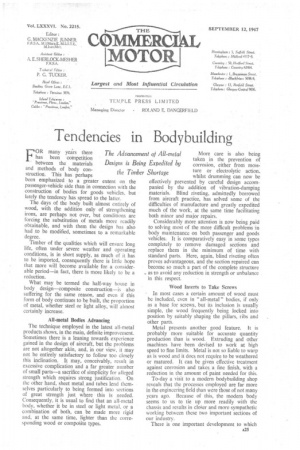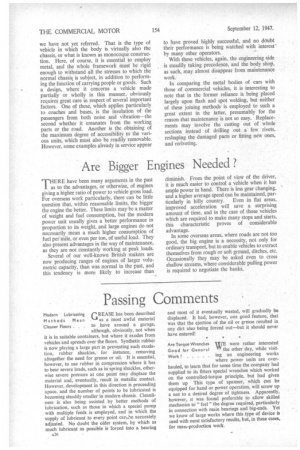Tendencies in Bodybuilding
Page 27

Page 28

If you've noticed an error in this article please click here to report it so we can fix it.
FOR many years there has been competition between the materials and methods of body construction. This has perhaps been emphasized to a greater extent on the passenger-vehicle side than in connection with the construction of bodies for goods vehicles, but lately the tendency has spread to the latter.
The days of the body built almost entirely of wood, with the addition only of strengthening irons, are perhaps not over, but conditions are forcing the substitution of metals more readily obtainable, and with them the design has also had to be modified, sometimes to a remarkable degree.
Timber of the qualities which will ensure long life, often under severe weather and operating conditions, is in short supply, as much of it has to be imported, consequently there is little hope that more will become available for, a considerable period—in fact, there is more likely to be a reduction.
What may be termed the half-way house in body design—composite construction—is also suffering for the same reason, and even if this form of body continues to be built, the proportion of metal, whether steel or light alloy, will almost certainly increase.
Ail-metal Bodies Advancing The technique employed in the latest all-metal products shows, in the main, definite improvement. Sometimes there is a leaning towards experience gained in the design of aircraft, but the problems are not altogether akin, and, in our view, it may not be entirely satisfactory to follow too closely this inclination. It may, conceivably, result in excessive complication and a far greater number of small parts—a sacrifice of simplicity for alleged strength which requires strong justification. On the other hand, sheet metal and tubes lend themselves particularly to being formed into sections of great strength just where this is needed. Consequently, it is usual to find that an all-metal body, whether it be in steel or light metal, or a combination of both, can be made more rigid and, at the same time, lighter than the corresponding wood or compogite types. More care is also being taken in the prevention of corrosion, either from moisture or electrolytic action, whilst drumming can now be effectively prevented by careful design accompanied by the addition of vibration-damping materials. Blind riveting, admittedly borrowed from aircraft practice, has solved some of the difficulties of manufacture and greatly expedited much of the work, at the same time facilitating both minor and major repairs.
Considerably more attention is now being paid to solving most of the more difficult problems in body maintenance on both passenger and goods vehicles. It is comparatively easy in some types completely to remove damaged sections and replace them in the minimum of time with standard parts. Here, again, blind riveting often proves advantageous, and the section repaired can become so much a part of the complete structure as to avoid any reduction in strength or unbalance in this respect.
Wood Inserts to Take Screws In most cases a certain amount of wood must be included, even in "all-metal" bodies, if only as a base for screws, but its inclusion is usually simple, the wood frequently being locked into position by suitably shaping the pillars, ribs and other parts.
Metal presents another good feature. It is probably more suitable for accurate quantity production than is wood. Extruding and other machines have been devised to work at high speed to fine limits. Metal is not so liable to warp as is wood and it does not require to be weathered or matured. It can be given effective treatment against corrosion and takes. a fine finish, with a reduction in the amount of. paint needed for this.
To-day a visit to a modern bodybuilding shop reveals that the processes employed are far more in the engineering field than were those of not many years ago. Because of this, the modern body seems to us to tie up more readily with the chassis and results in cloSer and more sympathetic working between these two important sections of our industry. There is one important development to which we have not yet referred. That is the type of vehicle in which the body is virtually also the chassis, or what is known as monocoque construction. Here, of course, it is essential to employ metal, and the whole framework must be rigid enough to withstand all the stresses to which the normal chassis is subject, in addition to performing the function of carrying people or goods. Such a design, where it concerns a vehicle made partially or wholly in this manner, obviously requires great care in respect of several important factors. One of these, which applies particularly to coaches and buses, is the insulation of the passengers from both noise and vibration—the second whether it emanates from the working parts or the road. Another is the obtaining of the maximum degree of accessibility to the various units, which must also be readily removable. However, some examples already in service appear to have proved highly successful, and no doubt their performance is being watched with interest by many other operators.
With these vehicles, again, the engineering side is steadily taking precedence, and the body shop, as such, may almost disappear from maintenance work.
In comparing the metal bodies of cars with those of commercial vehicles, it is interesting to note that in the former reliance is being placed largely upon flash and spot welding, but neither of these joining methods is employed to such a great extent in the latter, presumably for the reason that maintenancels not so easy. Replacements may involve the cutting out of whole sections instead of drilling out a few rivets, reshaping the damaged parts or fitting new ones, and reriveting.




















































































